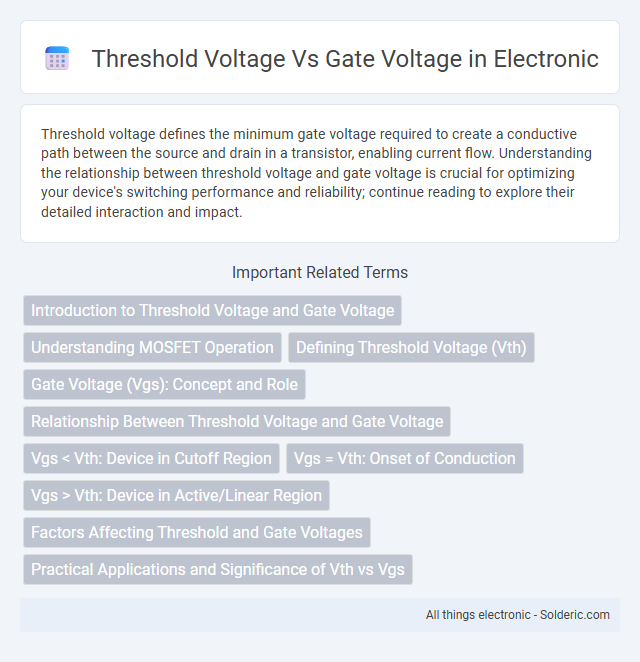Threshold voltage defines the minimum gate voltage required to create a conductive path between the source and drain in a transistor, enabling current flow. Understanding the relationship between threshold voltage and gate voltage is crucial for optimizing your device's switching performance and reliability; continue reading to explore their detailed interaction and impact.
Comparison Table
| Parameter | Threshold Voltage (Vth) | Gate Voltage (Vg) |
|---|---|---|
| Definition | Minimum voltage needed at the gate to create a conductive channel in a MOSFET | Actual voltage applied to the gate terminal of a MOSFET |
| Purpose | Controls transistor turning ON/OFF state | Controls the electric field to modulate channel conductivity |
| Typical Value Range | ~0.2 V to 1.0 V (depends on device type and technology) | 0 V to Vdd (Supply voltage, e.g., 1.2 V to 5 V) |
| Dependency | Material properties, device fabrication, temperature | External power supply or input signal |
| Effect on MOSFET | Sets the threshold for channel formation | Determines the conduction level when Vg > Vth |
| Role in Device Operation | Defines switching point | Controls device operation above or below threshold |
Introduction to Threshold Voltage and Gate Voltage
Threshold voltage is the minimum gate-to-source voltage required to create a conductive channel between the source and drain terminals in a MOSFET. Gate voltage controls the electric field that modulates the channel conductivity, directly influencing the device's switching behavior. Understanding the relationship between threshold voltage and gate voltage is essential for optimizing transistor performance and power consumption in electronic circuits.
Understanding MOSFET Operation
Threshold voltage (Vth) is the minimum gate voltage (Vgs) required to create a conductive channel between the MOSFET's source and drain terminals. When your gate voltage exceeds this threshold, it induces an inversion layer, allowing current to flow and enabling device switching. Accurate control of Vth relative to Vgs is essential for optimizing MOSFET performance and power consumption in electronic circuits.
Defining Threshold Voltage (Vth)
Threshold voltage (Vth) is the critical gate voltage at which a MOSFET channel begins to form and conduct current. It represents the minimum gate-to-source voltage required to create a conductive path between the source and drain terminals. Understanding Vth is essential for designing and optimizing your transistor-based circuits to ensure proper switching behavior.
Gate Voltage (Vgs): Concept and Role
Gate Voltage (Vgs) is the electrical potential difference applied between the gate and source terminals of a MOSFET, controlling the formation of the conductive channel. When Vgs exceeds the Threshold Voltage (Vth), it induces an inversion layer allowing current to flow between the drain and source. Precise manipulation of Vgs optimizes transistor switching behavior, influencing device performance in integrated circuits.
Relationship Between Threshold Voltage and Gate Voltage
Threshold voltage (Vth) is the minimum gate voltage (Vg) required to create a conductive channel in a MOSFET, initiating current flow between source and drain. The relationship between threshold voltage and gate voltage is fundamental in transistor operation, where the gate voltage must exceed the threshold voltage to switch the device from the off state to the on state. Variations in threshold voltage directly affect the gate voltage level needed for device activation, influencing transistor switching speed and power consumption.
Vgs < Vth: Device in Cutoff Region
When the gate-to-source voltage (Vgs) is less than the threshold voltage (Vth), the MOSFET operates in the cutoff region, meaning the channel is not formed and no significant current flows between the drain and source terminals. In this state, the device behaves like an open switch, effectively isolating the drain from the source. This cutoff condition is critical for digital circuits, providing a clear off-state for transistor switching and minimizing leakage current.
Vgs = Vth: Onset of Conduction
At the threshold voltage (Vth), the gate-to-source voltage (Vgs) initiates the formation of a conductive inversion layer in a MOSFET channel, enabling current flow between the source and drain terminals. When Vgs equals Vth, the inversion charge density becomes sufficient to overcome the depletion region, marking the onset of significant conduction. This transition defines the device's switching behavior and is critical for optimizing transistor performance in integrated circuits.
Vgs > Vth: Device in Active/Linear Region
When the gate-to-source voltage (Vgs) exceeds the threshold voltage (Vth), the MOSFET enters the active or linear region where the channel forms, allowing current to flow between drain and source. In this region, the device operates as a voltage-controlled resistor, and the drain current (Id) is primarily modulated by both Vgs and the drain-to-source voltage (Vds). Precise control of Vgs above Vth is crucial for optimizing transistor switching speed and maintaining efficient amplification in analog circuits.
Factors Affecting Threshold and Gate Voltages
Threshold voltage depends on factors such as doping concentration, oxide thickness, and temperature, which directly influence the voltage required to form a conductive channel in a MOSFET. Gate voltage is controlled by the applied voltage to the gate terminal, but its effectiveness in modulating the channel depends on the threshold voltage and interface states. Understanding these parameters allows you to optimize transistor performance for various semiconductor applications.
Practical Applications and Significance of Vth vs Vgs
Threshold voltage (Vth) defines the minimum gate voltage (Vgs) required to create a conductive channel in a MOSFET, directly influencing device switching behavior and power efficiency. Precise control of Vth compared to Vgs enables optimized transistor performance in analog and digital circuits, impacting noise margins, speed, and leakage current. Understanding your circuit's Vth versus Vgs relationship is crucial for designing energy-efficient electronics and achieving reliable operation across varying conditions.
Threshold voltage vs Gate voltage Infographic

 solderic.com
solderic.com